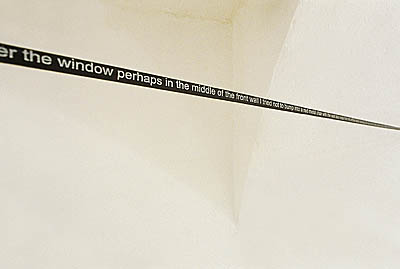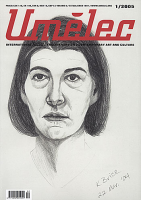| Zeitschrift Umělec 2005/1 >> Authentically Lived Stereotypes: The Hidden Phenomenon of Marriage Art | Übersicht aller Ausgaben | ||||||||||||
|
|||||||||||||
Authentically Lived Stereotypes: The Hidden Phenomenon of Marriage ArtZeitschrift Umělec 2005/101.01.2005 Lenka Klodová | study | en cs |
|||||||||||||
|
I am fascinated by the performances of Wladyslaw Kazmierczak and Ewa Rybska. Their many presentations are different, they are mostly political with poetic delivery of their subject matter, but I’m interested in them all in one particular way. When I see a middle-aged man and woman in tuxedos standing next to each other, I feel a strange tension emanating. Couples make me nervous, after all—much more than art groups. Unconsciously, you seek out a relationship between the two; a couple ought to speak about duality; you expect what is being relayed is to let us know something about complementary contradictions, about the fundamental principles of duality.
One can rely on this expectation and engage with it in various games of interpretation. Such is the genius of the Jasanský – Polák photographic duo; these are individuals who de-emphasize the artist’s role working with the camera’s single release. With Kazmierczak and Rybska I have to wonder what Ewa is doing. Their performances remind me remotely of some great magician ac- companied by his pretty assistant. But magicians’ assistants are usually episodic figures, with a complementary task. The mesmerizing man in a tuxedo manipulates reality, while a delicate woman, in a sequinned gown serves as decoration. But Ewa wears a dinner jacket, and with her large dark eyes, her glance is nothing if not that of a sphinx. No stereotyped gender complement, she’s an equal voice in a duet, Janus’ other face. And the performances of Kazmierczak and Rybska are of a single person, an androgynous individual with both a male and female figure. It’s a double-person open performance in space that raises questions and answers them; it is advantageous in all respects. These faces don’t solve themselves, they don’t vent any classic male-female stereotypes. Indeed, they’ve resolved these issues, so they can devote all their energy to outward expression—to the viewer and to the subjects of the performances. Whilst in the Czech Republic there are no such two-headed creatures among artists, we can find some art theoreticians who are so disposed: The Ševcíks. That’s Jana and Jirí Ševcík, Czech curators and art theoreticians. Their articles and curatorial projects, especially from the nineties, were finished as androgynous projects, a blend of two ingredients that could have been done in a home lab. Setting the Notion Both Kazmierczak and Rybska and the Ševcíks are model situations in which two circles mingle: The professional and the life partnership. Let us define a new term “marriage art.” Before we elaborate this term further, we need to speak of works that fit into such a category. We have already spoken of a variant we could call tautology, ideal overlap. The partners claim to be identical and that is not Utopian. Any differences are consumed privately; outwardly, they present their refined, common works. The collective projects of Erik and Gabriela Binder can be considered “marriage art.” The Slovak theoretician Gabriela Garlatyová describes the development of this cooperation: “The couple’s first name was the pseudonym Mars and Venus Binder, which they used for their project Okná Priestoru dokorán (Priestor Windows Wide Open), presented in the Priestor Gallery in Bratislava. Later they called themselves 2JA and in doing so, playfully worked as a configuration of allies. Most recently, they are Kunst-fu, an outgrowth of Erik Binder’s concept of Kunst-fu.“1 The 2JA exhibition at the City Gallery in the Slovak town of Rimavská Sobota, was accompanied by a “treaty of cooperation and spheres of influence” (verified by a notary public), whose subject was “laying down the rules and delimiting spheres of influence for the purpose of simplifying cooperation and preventing potential misunderstanding.”2 Garlatyová describes their method of working as something beyond collective participation where each partner comes to a project half way. Often they enter a work already realized by the other with a fresh idea or commentary. “Marriage art” need not necessarily be a collective effort of two creating individuals; often the partners influence the artist’s creation as mediators. They can be an inspiration for the artist, they can offer a face or figure as a model. But it is true that when a partner appears in the work of the artist, the work gains additional value without formally differing from other portraits. It speaks of partnership, about the willingness to work artistically with intimate themes. Such work endows additional meaning to the institution of marriage and partnership, and defines its limitations and present day problems. We can illustrate very clearly the shift that occurs when the model in the artist’s work is also their life partner. Jeff Koons’ Made in Heaven is a well-known series of sculptures of various dimensions and materials, and large format photographs that were made in cooperation with Ilona Staller. This cooperation could be considered a finished art concept, an effective connection of two quantities: a partnership focused on the purpose of creating art work. Jean Christophe Ammann says in the study Triumph out of Failure: “Behind his cooperation with Ciociolina is a concrete utopia. Only he himself, as an artist, together with a porn-star could try to materialize fiction, to show that a real art creation lies in the articulating of ideas, obsession and passions of every individual. Ciociolina was important for him not only because of her porn career, but also for her role as a member of the Italian parliament.”3 Jeff Koons really required a bride to realize his project. That way he avoids the accusation of pornography as the sexually explicit pictures take on a stronger, morally richer meanings. As Koons himself says, he wanted Made in Heaven to “show the beauty of simple things, so that people would be able to accept their history...Ilona was stressed here as my desire. I wanted to evoke desire in the viewer, but not the desire for the object of my desire. I wanted to create an objective situation so that people could feel their own desire. And therefore feel that they can realize anything in their lives...”4 The concept of marriage as a sexual condition, or a state of fulfilled sexual realization, doesn’t often appear in art. We might find historical references in Czech art such as the beautiful brochure “Twenty-one,” 21 of Toyen’s drawings, created as a wedding present for the brother of the art theoretician and psychologist Bohuslav Brouk. The drawings are composed as a manual for newly-weds and shows in poetic, naive, tenderly colored drawings in pen, gentle plays of marital sexuality—and small tragedies, dreams and dependencies. The esprit du temps is explained in the radical thoughts of Bohuslav Brouk himself, the brother-in-law of the bride, who completely rejected the institution of marriage, considering it unworthy for human kind. For him, women who entered into marriage were no different from prostitutes: they offered sexual services for payment, for a piece of food and the illusion of a comfortable position in society.5 Whatever the relation of woman to man, man to woman, whoever is the creator and whoever is the model, there is usually a hierarchical relationship involved. If it were possible to approach a phase when this hierarchy, and the dispute about it ceased to be a defining category for the relationship, work collective or individual, such as we mentioned, in the couples of Kazmierczak - Rybska and the Ševcíks, the benefits would be significant. It isn’t necessary to criticize hierarchy as such; it is a common and functional way of living and organizing life. Indeed, for some, it is an aspiration. Dan Flanagan categorized his works as sadomasochistic relationships, masochistic, and the baby-like living of life of an incurably sick man. He turned his attention towards ignored forms of coexistence and demonstrated how we are able to accept and without problems categorize only a very small and stereotypical part of normal, well-known heterosexual relationships. His projects Supermasochist and Visiting Hours, realized with his partner Sheree Rose are visually sensational, yet they describe the most basic of human needs. The categorization of his own ill health as well as sexual orientation carries in itself a general desire for health, in contrast to the ghettoization of the ill, calling for the right of the sick to love. In this context, it is worth mentioning a series of seriographies by Jirí Suruvka that work with hierarchy. In the prints of official married couples he parodies official double-portraits of Václav and Olga Havel with his own variation. The artist offers another interpretation: “I was ill at the time, and Olga Havlová was too. The partner standing by the ailing one sitting is hoping to both protect him and be in the last photograph with him.“ There are many more examples, but I consider these so far as sufficient proof of the existence of the phenomena of “marriage art.” This can be defined as an art produced partnership, possibly institutionalized, that speaks of social, psychological, erotic and gender problems. It is such an authentic and rich phenomena that it really deserves detailed study, or a smaller but self-sufficient scientific field. I look forward to situations when we will have to explain, under the fire of journalists’ questions, that not every artist-husband/wife must necessarily create “marriage art.” Notes: 1. Gabriela Garlatyová, Kunst-fu family – Kunst –fa of Erik and Gabriela Binder, in: catalogue Kunst-fu, Slovenská národná galérie, Bratislava 2003, p. 57 2. ibid 3. Jean Christophe Ammann, Triumph out of Failure, in: Heft Koons, Taschen, Cologne 1992, p.7 4. ibid 5. viz Bohuslav Brouk, Manželství – sanatorium pro méněcenné, in: Bohuslav Brouk, Autosexualismus a psychoerotismus, Praha, Odeon 1992
01.01.2005
Empfohlene Artikel
|
|||||||||||||













Kommentar
Der Artikel ist bisher nicht kommentiert wordenNeuen Kommentar einfügen